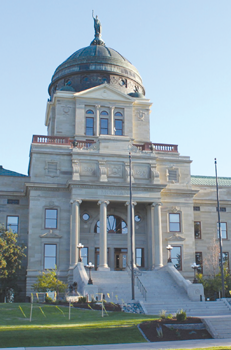State Legislature – Moving Fast
By Dan Brooks, Billings Chamber of Commerce
Now that we’re a few weeks into the Legislative Session, the question often arises, “How’s it going in Helena?” I pause and think of quoting a favorite tragic hero, trekking toward the Gap of Rohan: “It’s moving fast …and against the wind.”
Over 550 bills have been introduced so far—almost 200 more than this time during the 2021 Legislative Session which was an exceptionally busy session with 1,313 bill introductions.
With more than 4,500 bill draft requests in, this session is on pace to introduce more legislation than 2021 and has the potential to eclipse 2007 as the session with the most bills introduced in the last 20 years. Legislators are limited, however, by how much the state’s bill drafters (legislative staffers who actually write the new laws) can take on. Judging by the current trend line of bill introductions, and considering General Bills (not Revenue, Appropriation, or Referenda Bills) cannot be introduced after February 23rd, I’d be surprised if this session surpasses 2007 for the most introduced bills.
Even if this session isn’t record-breaking in that respect, it is still extremely busy. If you’re looking for tools to help you keep up, our Data Dashboard is tracking a few session statistics. You can also find out:
Which local legislator has the most bills introduced and how many bills our local delegation is working on? Granted, this isn’t an entirely fair comparison as a few legislators are carrying bills such as SR 43, “Confirm governor’s appointees for the board of housing.” These bills aren’t proposing changes to the law, but are necessary to conducting government business.
The number of bill hearings in various policy committees. Curious what the legislature is spending most of its time debating? Other than the budget, the House and Senate Business & Labor Committees are racking up the most hearings so far.
Senate Bill 145 — Local distribution of lodging tax revenue, Sen. Keith Regier (R) SD 3 – Chamber opposes. This bill redirects funding from the Department of Commerce and the General Fund to go toward property tax relief. As is often the case, policy makers propose ideas to re-divide the same metaphorical pie, robbing Peter to pay Paul, as the saying goes. In this case, diverting money from Dept. of Commerce that funds tourism grants and programs may lead to a reduction in tax collections, which the sponsor wants to go toward property tax relief. If the bill solely redirected funds from General Fund, the Chamber would have no concerns. The bill was heard in (S) Tax on Wednesday, January 18.
House Bill 245 — Revise credit for trades education and training, Rep. Sue Vinton (R) D 56— Billings Chamber supports. This bill builds on the success of the Montana Trades Education and Training Tax Credit, established last legislative session, which offers a credit for 50% of an employee’s education, up to $2,000 annually. HB 245 expands the number of occupations and industries that qualify for the tax credit. The Department of Labor estimates the current credit covers 38,000 employees. The expansion offered by HB 245 would include an additional 31,130 employees. This is a great program for getting our workforce additional education.
A few of Governor Gianforte’s tax proposals are up for debate, Among the proposals are a couple the Billings Chamber is eager to support.
The first is House Bill (HB) 212, a bill to increase the business equipment tax exemption from $300,000 to $1 million. Meaning, businesses with market value of class 8 property less than $1 million are exempt from taxation. And those businesses with class 8 property valued at over $1 million will see reduced taxes.
For Yellowstone County, that means significant savings to our business community. There are 502 entities with business equipment tax liability in tax year 2022. House Bill 212 would fully exempt 273 entities, reduce liabilities for the remaining 229, and provide a total savings of $1.293 MILLION to businesses in Yellowstone County.
The Billings Chamber has long been a supporter of reducing or eliminating the business equipment tax. We were enthusiastic supporters of raising the exemption to $300,000 during the 2021 Session, and we believe HB 212 is an even better step in the right direction.
Another tax bill making it’s debut this week is Senate Bill (SB) 121. This bill would lower the top marginal income tax rate from 6.5% to 5.9%. It also comes with significant benefits to Yellowstone County taxpayers. The Department of Revenue estimates SB 121 will result in a tax savings of $20.5 million for Yellowstone County taxpayers in tax year 2024. With many of our small businesses filing as pass-throughs, this means more money to reinvest in their businesses.
Reducing Montana’s top income tax rate to 5.9% would allow the state to take a step down from the top of the tax rate podium. Currently, Montana holds the title for highest top marginal tax rate among our neighboring states. See the graphic below and note that it lists the state’s top rate as 6.75 in January 2022 rather than 6.5, which would go into effect in 2024 per legislation passed in 2021.


0 comments